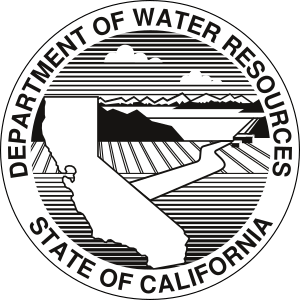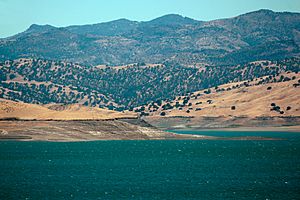California Department of Water Resources facts for kids

Seal of the California Department of Water Resources
|
|
| Agency overview | |
|---|---|
| Formed | 1956 |
| Preceding agencies |
|
| Headquarters | 715 P St, Sacramento, California |
| Agency executive |
|
| Parent agency | California Natural Resources Agency |
| Website | http://www.water.ca.gov/ |
The California Department of Water Resources (DWR) is a government group in California. It helps manage and control how the state uses its water. The DWR was started in 1956 by Governor Goodwin Knight. This happened after big floods hit Northern California in 1955. The DWR brought together several older water groups. Its main office is in Sacramento.
Contents
History of Water in California
Early Water Rules: 1850-1875
California has different ways of deciding who can use water. Before 1848, California was part of Mexico. Back then, a common water rule was "riparian rights." This meant that if you owned land next to a river, you could use the water from that river on your property. When California joined the United States, these old rules were mostly kept.
When gold was found in 1848, many people moved to California. During the California Gold Rush, miners used a lot of water for hydraulic mining. They would take water from rivers and streams. Miners often shared water based on local customs. They also started a new rule called "appropriative water rights." This meant you could claim water just by taking it and using it for something good. Miners would often put up signs to show they were using water.
After California became a U.S. state in 1850, new laws were made about water. The state adopted some English laws, including riparian rights. But soon, California courts also recognized appropriative water rights. This led to arguments because there were two different ways to claim water. The courts had to settle these fights.
In 1872, a new process was created. People claiming appropriative water rights could record their claims. In 1886, a big court case, "Lux v. Haggin," helped sort out fights between riparian and appropriative users. But soon, too many people were claiming water rights. This started to slow down California's growth. So, the governor created a Water Commission. This group suggested new water laws. In 1913, Californians voted to approve the Water Commission Act. This law created the State Water Commission. It also set up a way to get permits for appropriative water rights.
In 1926, courts ruled that landowners with riparian rights could use all the water from a stream, even if it wasn't a reasonable amount. To fix this, in 1928, California's main law, the California Constitution, was changed. It now says that all water use in California must be "reasonable and beneficial."
Planning for Water: 1875–1925
In 1878, William Hammond Hall studied California's Central Valley. He drew up plans for government-funded irrigation projects. Even without a state project, the Central Valley kept growing. Landowners and cities like San Francisco got water rights in the Sierra Nevada mountains.
The Water Commission Act of 1913 was important. It created the Water Commission to manage permits for using surface water. This law started on December 19, 1914. People who were already using water before 1914 often got "senior water rights." This meant they had first claim to water in many areas.
In 1919, Robert B. Marshall of the U.S. Geological Survey suggested a big plan. He wanted the federal government to build dams and canals. These would irrigate California's Central Valley. People in California were very interested in this idea.
Big Water Projects Begin: 1925–1950
In 1927, California passed a law. It allowed the Department of Finance to claim unused surface water for future projects. Many claims were made on July 30, 1927. The department then got permits for some of these water rights.
In 1933, the California State Legislature and Governor James Rolph approved building the Central Valley Project. The first plans were for a large dam at Kennett. This dam would help control water flow to the San Francisco Estuary. It would also reduce salty water from entering the Sacramento-San Joaquin Delta. California couldn't pay for the Kennett Dam alone. So, the state asked the federal government for help. In 1935, the U.S. Congress gave the U.S. federal government control over the Central Valley Project (CVP).
Creating the DWR and the State Water Project: 1950–1975
In the mid-1950s, California was growing very fast. People needed more water for homes and farms. In 1954 and 1955, Caspar Weinberger led meetings to discuss creating a State Water Project. This project would supply water to meet the state's growing needs.
On July 5, 1956, Governor Goodwin Knight signed a bill. This bill created the new Department of Water Resources (DWR). It combined several existing water groups. Harvey Oren Banks became the DWR's first director. His job was to plan the new State Water Project.
In 1959, a law called the Burns-Porter Act was passed. It allowed $1.75 billion to be used for building the State Water Project. Californians approved this act in 1960. That same year, the Whale Rock Dam was finished. It was the DWR's first major water project.
In 1961, William Warne became the DWR director. He oversaw the building of the Oroville Dam. This dam is a key part of the State Water Project. The DWR also worked with the United States Bureau of Reclamation to design a joint reservoir in San Luis. Water from the Oroville and Shasta dams would flow down the Sacramento River into the Sacramento-San Joaquin River Delta. From there, extra water would be stored in the Central Valley. Construction of the Harvey O. Banks Pumping Plant also began in 1963.
DWR Timeline: Key Events
| Year | Event(s) |
|---|---|
| 1850 |
|
| 1878 |
|
| 1887 |
|
| 1919 |
|
| 1929 |
|
| 1933 |
|
| 1951 |
|
| 1955 |
|
| 1956 |
|
| 1957 |
|
| 1959 |
|
| 1960 |
|
| 1961 |
|
| 1962 |
|
| 1963 |
|
| 1964 |
|
| 1965 |
|
| 1966 |
|
| 1967 |
|
| 1968 |
|
| 1969 |
|
| 1970 |
|
| 1971 |
|
| 1972 |
|
| 1973 |
|
| 1974 |
|
| 1975 |
|
| 1982 |
|
| 1983 |
|
| 2007 |
|
The State Water Project
What the Project Does
The State Water Project (SWP) delivers water to about two-thirds of California's people. It includes:
- 34 storage places, like reservoirs and lakes.
- 20 pumping plants that move water.
- Four plants that both pump water and make electricity.
- Five power plants that use water to make electricity.
- About 701 miles of open canals and pipelines.
State Water Project Facts
| Number of Storage Facilities |
33 |
| Lakes/Reservoirs (main ones) |
21 |
| Total Reservoir Storage |
5.8 million acre-feet (enough water to cover 5.8 million acres one foot deep) |
| Highest Dam Structure |
770 feet (235 meters) |
| Largest Yearly Energy Output |
8.57 Billion kWh (in 2002) |
| Average Net Energy Use |
5.1 Billion kWh |
DWR Projects and Facilities
Moving and Storing Water
- Oroville Dam (built in 1967)
- North Bay Aqueduct
- Clifton Court Forebay
- Harvey O. Banks Pumping Plant (built in 1968)
- South Bay Aqueduct
- California Aqueduct (a long system of canals)
- West Branch
- East Branch
- Coastal Branch
- O'Neill Forebay
- San Luis Reservoir (built in 1967)
- Whale Rock Dam (built in 1960)
- Edmonston Pumping Plant (built in 1971)
- Silverwood Lake
- Lake Perris
Controlling Floods
- Sutter Bypass
- Tisdale Weir
- Tisdale Bypass
- Sacramento Weir
- Yolo Bypass
Fun Recreation Areas
- Antelope Dam (built in 1964)
Helping Nature and Wildlife
The DWR also works on projects to lessen the impact of the State Water Project. These projects help protect the environment.
- Feather River Salmon and Steelhead Hatchery (1967)
- Thermalito Afterbay (1968)
- Yolo Bypass Wildlife Recreation Area
- Suisun Marsh
- Skinner Fish Facility
- South Delta Improvements Program
- South Delta Temporary Barriers Program
Leaders of the DWR
Here is a list of the people who have led the DWR.
| Director | Time in Office | Notes |
|---|---|---|
| Harvey Oren Banks | July 5, 1956–December 12, 1960 | First director of the DWR. |
| William E. Warne | January 1, 1961–December 30, 1966 | |
| William R. Gianelli | January 1, 1967–April 31, 1973 | |
| John R. Teerink | September 1, 1973–March 3, 1975 | |
| Ronald B. Robie | March 6, 1975–December 31, 1982 | |
| Howard Eastin | January 3, 1983–June 21, 1983 | Temporary Director |
| David N. Kennedy | June 22, 1983–December 31, 1998 | |
| Thomas M. Hannigan | March 1, 1999–June 1, 2003 | |
| Michael J. Spear | June 9, 2003–November 16, 2003 | Temporary Director |
| Linda S. Adams | November 17, 2003–February 23, 2004 | First female director of the DWR. |
| Lester A. Snow | February 24, 2004–January 31, 2010 | |
| Mark W. Cowin | February 1, 2010–Dec 31, 2016 | |
| Bill Croyle | January 1, 2017 - July 1, 2017 | Temporary Director |
| Grant Davis | July 19, 2017 - January 10, 2018 | |
| Karla Nemeth | January 10, 2018 – Present |
Water Regions
See Also
- California Department of Water Resources dams
- California Environmental Protection Agency (CAL EPA)
- California State Water Resources Control Board (SWRCB)
- Southern California Coastal Water Research Project
- United States Bureau of Reclamation
- Water in California topics


